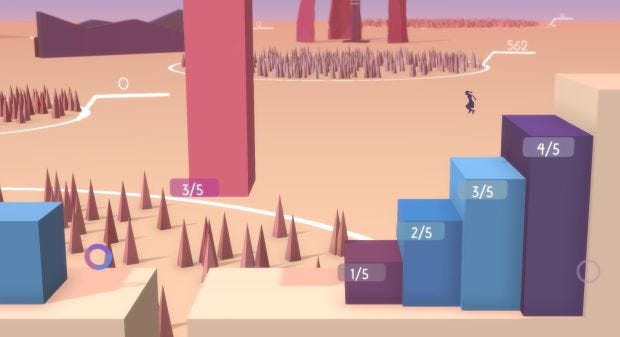Wot I Think: Metrico+
Off the rails
Originally released on Playstation Vita in 2014, the recently released infographic-themed puzzle platformer Metrico+ [official site] is a port with extra content for PC and consoles. Does it survive the transition from weeny-screened handheld to big-screened behemoth? Here’s wot I think:
It’s reasonably awkward to explain the nature of Metrico+ without spoiling the nature of the game’s puzzles. The side-scrolling 2D platformer’s puzzles invariably involve working out the mechanics of a particular level, and then employing them, rather than having an emphasis on reflexes or timing. Perhaps it will be that moving to the left causes elements on the screen to move to the right, so you need work out how to progress to the right with that in mind. Maybe jumping is the key in this level, but too much jumping makes progress impossible? It’s that sort of thinking, messing about with the interaction to see the cause and effect, and then attempting to apply that successfully.
Which is to say, it’s not a wholly original puzzle platformer, instead rather strongly relying on its presentation to distinguish itself. Often looking like a CFO’s powerpoint presentation, it picks up on themes of graphs, bar charts, rising and falling percentages, visual information and pictorial diagrams, with your character’s actions manipulating these bars and columns to create paths.
This is a lovely idea, but a very inconsistent one. At the same time, there’s the rather incongruous choice to have rolling hills or geographically peculiar landscapes in the background. And then a tube-map-style presentation for level selection. And then there are the surrealist segments between levels seemingly in space... And the whole thing very quickly reveals a real muddle of ideas with no consistent theme. If anything, it’s a bit of a list of “things that tend to get used”, a collection of overworn schematic diagrams, rather than anything intrinsic or specific to what the game is attempting to deliver.
The process of each puzzle is to work out what causes what. Does jumping make that pillar move? Permanently? Can firing a weapon (later in the game) reverse that movement? Can that sliding bar be blocked by that descending column if I run backward? Then you restart the level and apply what you’ve learned.
Further in, restarting levels becomes a predominant tactic, where some movement of elements is retained. However, this is oddly inconsistent, once again emphasising the exploration of the mechanic over the action of implementing it. Which, for me, becomes a little wearying after a good few levels. At a certain point it feels like walking into yet another room with yet another set of coloured potions, and having to taste each to work out which kills you and which makes you fly. By the fourth chapter you’re inevitably exploring whether failure is progress, or hinders later progress despite appearing to further it now, or whether the new restart option that’s replaced the previous restart option which is now mostly a mechanic is about to lose its own previous boundaries too, and so on. Which is definitely interesting. Although at a certain point, when faced with a big screen of moving platforms and pillars, each determined by a different mechanic, it becomes exhausting.
Where at the start I was enjoying manipulating the levels, albeit in ways I’ve seen in a dozen other Steam platformers, toward the end I was looking at a new level and just feeling tired instead of motivated. It becomes not a case of not knowing how to finish a level, but a case of wondering if I’ve really got the energy and patience to do it. This is further encumbered by some very floaty movement, your character (a silhouette either male or female) frequently sliding off ledges, meaning you have to restart the entire puzzle. I think my passion to persist might be a little stronger if I weren’t also having to worry about such slippery controls, as well as annoying glitches like the gun failing to fire when the button is pressed, screwing up anything requiring timing.
A fair amount is also lost with the move from Vita, most especially levels requiring physical manipulation of the device. Obviously you can’t tip your PC left or right, or give it a shake (okay, yes, you can, but it’s likely to have a different effect on the game than intended), which takes away from the game’s exploratory nature. Levels have been rejigged, put in a different order presumably to better balance difficulty, and new ones have been added to replace the disposed.
Occasionally, as I persist, I find another level that’s brilliantly smart and makes me feel terribly clever for correctly figuring it out. But these moments of being uplifted are quickly deflated by another busywork level of faffing and fiddling until you’ve negotiated half a dozen conflicting obstacles, leading to a feeling of tired relief rather than pleasure on completion. And that becomes the theme for me, of frustration interspersed with delight. Perhaps it is a metaphor for life.
Metrico+ really needs a lot more focus. It’s throwing an awful lot at the wall, and while there’s certainly a great deal of smarts at play here, they’re not united, not well contained. Slidey controls do little to help, but in the end for me it’s the lack of a coherent aesthetic that feels the most disappointing. It feels too much like a portfolio, and not enough like a cohesive, deliberate piece of work, and certainly not one that adequately evokes the feeling of infographics.
Metrico+ is out now on Steam for a not inconsiderable £10.59/$13.99.













